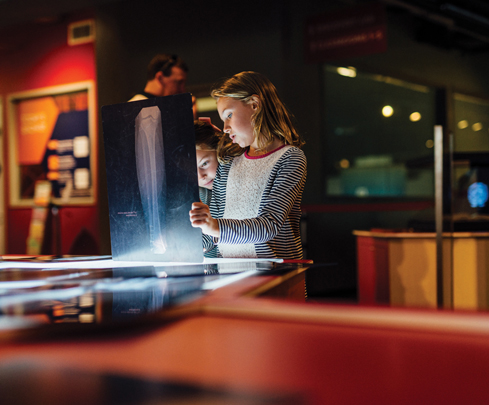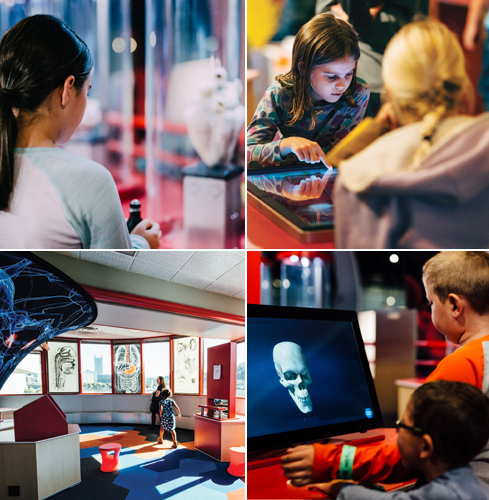Winter 2016
  |
||||||
|
|
In its new permanent exhibit, BodyWorks, the Science Center invites visitors to get know themselves better from the inside out.
Have you ever looked in a mirror and wondered what makes you ... you? You wouldn’t be alone—it’s the question we ask ourselves about a new hairstyle and the reason we fret over our first wrinkles. It’s also the ultimate, soul-searching, existential question of humanity. But what if you look even deeper? Really deep. Like, to the bone.
“It does cool stuff!” the toddler exclaims. Stooping down like a frog, he croaks as he hops around on his hind legs. He squeals in excitement watching his skinless doppelganger frog-hop, too. Schanbacker is trying out the skeleton mirror, one of the interactive highlights of BodyWorks, the Science Center’s new permanent offering all about the marvelous machine known as the human body. Years in the making, BodyWorks is among a host of new and re-energized exhibits made possible through SPARK! A Campaign for Carnegie Science Center, which launched in 2014. The effort aims to grow the Science Center’s already expansive reach through increased programming as well as a new Science Pavilion that will house STEM Learning Labs and a new space for world-class traveling exhibits. Developed in partnership with Allegheny Health Network (AHN), one of the region’s largest hospital systems, BodyWorks seeks to answer the profound and complicated question of how the human body functions. The science behind it is personal—and captivating. Visitors like Leo are encouraged to explore the physiology, biology, and engineering of their bodies through interactive displays and real, preserved body parts. A half of a human skull, cut vertically, displays details such as the taste buds and nose hairs. A real human arm is paired with an interactive exhibit where visitors can use an artificial arm to twist open a door knob. It turns out that this simple act requires complicated movements of some two dozen bones. “As kids learn more about normal body function and illness, they can be more comfortable with the difficult issues they will need to deal with throughout life. They may also be motivated to help others or consider a medically related career."
- Dr. Richard Ray, bodyworks advisorBodyWorks balances out hard-core anatomy lessons with more whimsical displays. Consider the “fart stools.” Technically they’re called gas seats, but Dennis Bateman, the Science Center’s director of exhibits and theater experiences, prefers the term favored by the target demographic—middle school students. Kids (and some kid-like adults) bounce up and down on the stools, and each landing expels a burst of air, launching a pong ball in the air and triggering many giggles with the realistic sound of passing gas. Differing amounts of pressure creates different noises and different snorts of laughter. With it comes this simple lesson: Many healthy foods, like beans, broccoli, apples, and peas, can cause gas production in your gut; but the nutritional benefits of these foods far outweigh the 10-20 farts everyone produces each day. Another sure-to-be kid favorite: an artificial human body with a section of rope—the “guts”—hanging out of the abdomen. By yanking on the rope, visitors pull out 30 feet of “intestines,” the same length of small bowel in a typical adult. By letting go of the rope, the guts snap back into place like a vacuum cleaner cord. Museumgoers can also try their hand at performing a sonogram. The simulation uses an artificial pregnant belly designed to emit infrared light and a hand-held wand with a special sensor. By manipulating the wand over the belly, visitors can activate one of three video loops—a single baby, twins, or a 3-D sonogram image. To ensure a realistic belly, Bateman enlisted the help of pregnant co-worker Danni Piccolo. Last January, when the staff was designing the sonogram exhibit, Piccolo happened to be nine months pregnant. When she mentioned an upcoming appointment with her obstetrician at West Penn Hospital, Bateman asked if she would be willing to share the circumference of her stomach for the integrity of the exhibit. She and her doctor happily obliged. “In five years, she’ll be able to bring her daughter in and point to the stomach and say, ‘That was you in there,’” Bateman says.
How and Why?While sure to be a conversation starter for kids and adults alike, BodyWorks is designed to complement middle school curriculum, where health classes often include human anatomy and science lessons highlight the organ systems of other species. Science Center educators teamed up with AHN medical consultants to craft what they hope is “the perfect balance of fun and excitement with real substance that teachers can tap into,” says Brad Peroney, program development coordinator at the Science Center.It’s in middle school, Peroney says, when the questions start multiplying: How does my heart work, what does my stomach look like, how much blood pumps through my body? Eventually, the queries turn more complex: How do I stay healthy and what happens when things go wrong? The idea behind BodyWorks is simple: If kids better understand their own bodies, they’ll better understand how to care for them. And in a society filled with an overweight, overmedicated, and sleep-starved majority, it seems the best medicine could be a healthy dose of body education. “When their stomach is upset, when they have a headache, when they break an arm, you want them to have a better understanding of what’s happened,” says Bateman. BodyWorks is the third and final phase of BodyTech, a major health and science initiative developed by the Science Center, AHN, and Highmark. Already entertaining and educating audiences is BodyStage, a live demonstration theater, and Anatomy Adventure, a traveling science show that goes into schools to take kids on a virtual voyage through the body’s bloodstream, with live shows about how the body’s internal organs function. All told, BodyTech encompasses the entire third floor of the Science Center, validation of the city’s innovative and ever-growing medical and technological communities. Just as the Science Center’s H20!: Why Our Rivers Matter exhibit focuses on the rivers that converge in Pittsburgh, BodyWorks taps into the medical specialties and expertise of its world-class medical centers. As Science Center designers and educators developed the exhibits and accompanying text, retired AHN surgeon Dr. Richard Ray and other AHN medical experts provided professional input and fact-checking to make sure the anatomy and medical terminology were correct. “You want to make sure things are not upside down or applied in an incorrect way,” says Ray. “But you don’t want so much complex writing that it doesn’t interest people. Especially middle schoolers. Kids are naturally attracted to science, especially when they can relate whatever they see to themselves. “Most kids are exposed to medical issues within their families or school settings,” Ray notes. “Some normal aspects of growth and body function may also be concerning to kids. As they learn more about normal body function and illness, they can be more comfortable with the difficult issues they will need to deal with throughout life. They may also be motivated to help others or consider a medically related career when they see how much difference they can make in another person’s life.” Ray gave input on the “replacement parts wall,” as well—a display of innovative medical devices invented throughout history. Knowing that the Science Center wanted a range of prosthetics—from a woman’s Victorian-era wooden leg to the latest 3D-printed hands—Ray directed them to Pittsburgh-based Union Orthotics and Prosthetics to gather state-of-the-art artificial limbs used in a human model, which also includes a glass eye and an artificial heart valve. Other regional innovators whose work is reflected in BodyWorks are Tom Mitchell, a professor of machine learning and computer science at Carnegie Mellon University, and Marcel Just, professor of psychology and director of Carnegie Mellon University’s Center for Cognitive Brain Imaging. The two researchers use machine-learning algorithms to analyze functional brain activity through magnetic resonance imaging data, and their computer program allows them to decode what word someone is thinking about based on the neural activity captured in the data. Their research is now on display in BodyWorks’ BrainScan WordPlay, where Science Center visitors can view how different areas of the brain light up as they read various words. Researchers at the Pittsburgh Supercomputing Center lent their expertise and “big data” processing to create BodyWork’s hypothetical interactive model of how three diseases would spread across Pennsylvania. Bateman and his team also found a way to showcase the artistry of the human body by creating dramatic banners, each featuring body-themed images suggested by the other three Carnegie Museums. Carnegie Museum of Art provided an image of Alberto Giacometti’s elongated bronze figure Walking Man, an iconic piece in the museum’s collection. The Andy Warhol Museum offered images of Andy in a photo booth, taking pictures of his hand and the side of his face. And Carnegie Museum of Natural History provided an image of its popular boy mummy. “It’s not just all about hard science,” Bateman says of the new exhibit. “The human body is something that artists have been interpreting for years.” BodyWorks, he notes, should appeal to everyone from toddlers to their grandparents, from budding athletes to aspiring philosophers. “The show is about what makes you tick, how long your intestines are, and how your brain works. Everyone is fascinated by themselves.”
|
|||||
Also in this issue:
Art as an Equalizer · Earth in the Age of Humans · Strength in Numbers · President's Note · NewsWorthy · Face Time: Jeffrey Inscho · Science & Nature: Lion Attacking a Dromedary · Artistic License: New Voices of Appalachia · About Town: Reconstructing Pittsburgh's Atomic Past · Travel Log · The Big Picture
 |
Copyright © 2017 CARNEGIE Magazine. All rights reserved. |


